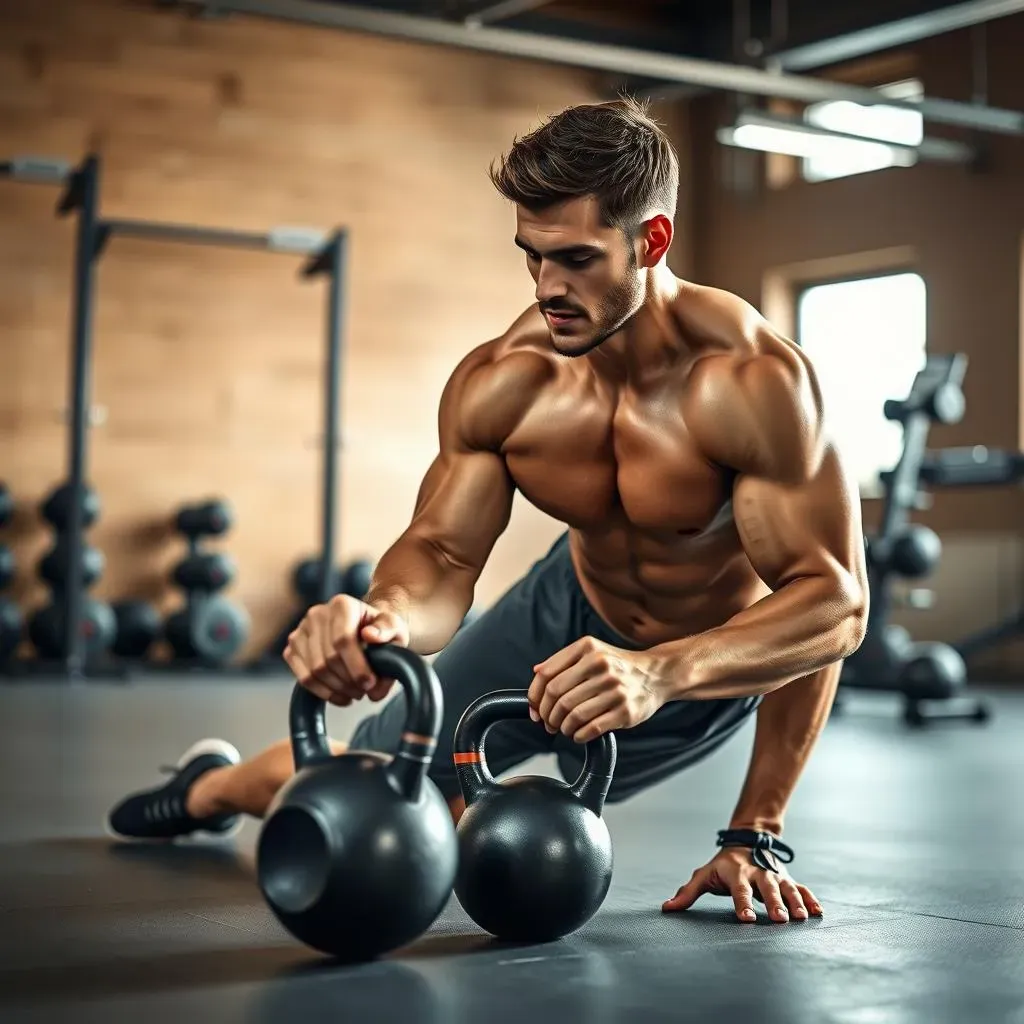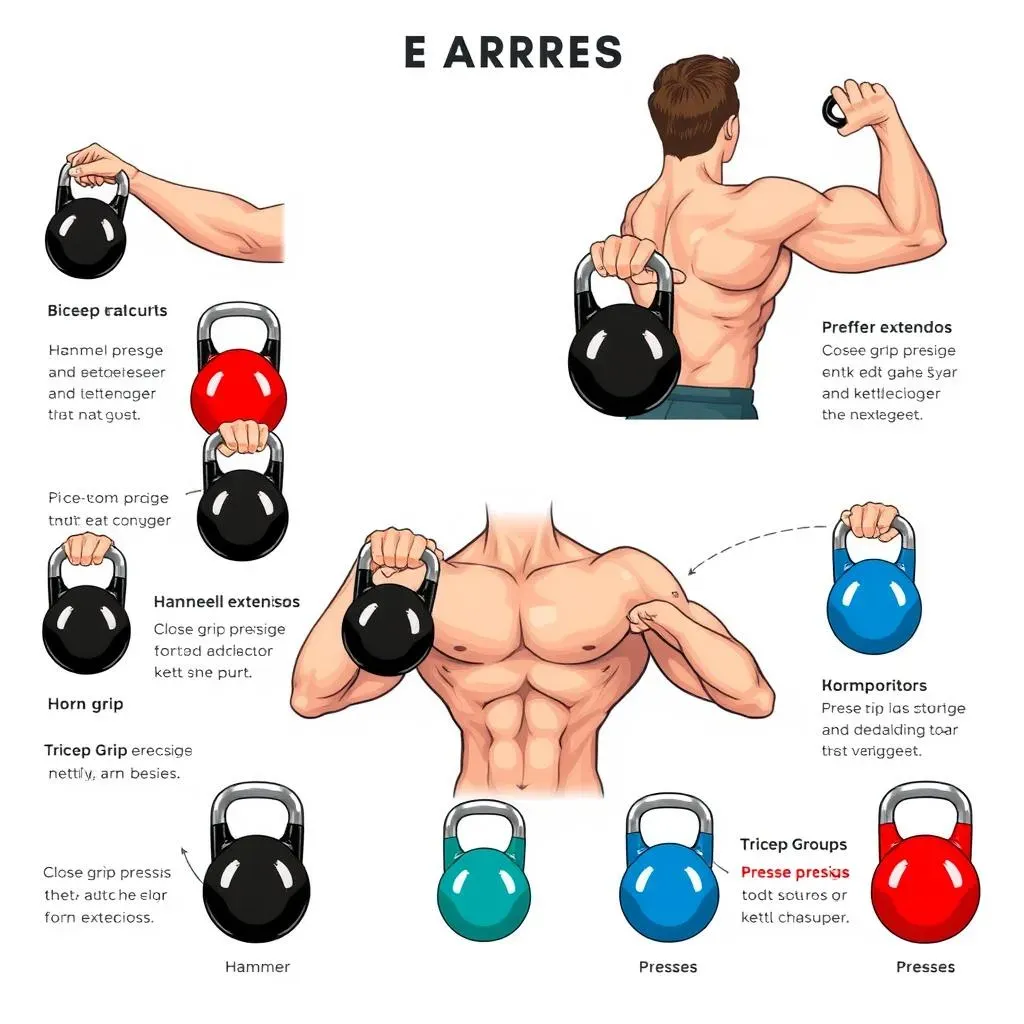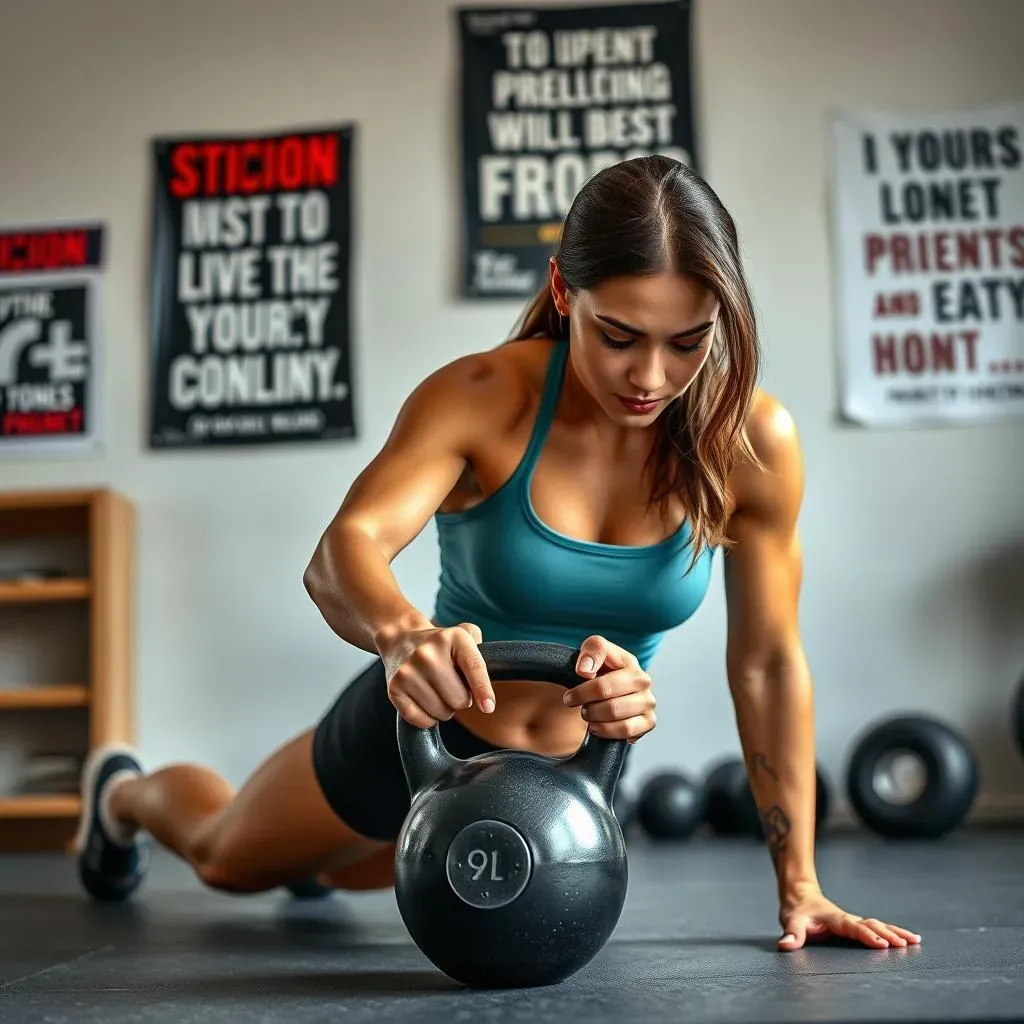Table of Contents
Hey, wanna build some serious strength? Forget those bulky gym machines, let's talk kettlebells. We're diving into the world of "kettlebell workouts for chest and arms," and trust me, it's a game-changer. I used to think kettlebells were just for swings and squats, but boy, was I wrong. They're fantastic for sculpting your chest and arms, giving you that lean, powerful look. This isn't just about lifting weights; it's about functional fitness, building real-world strength. We'll explore why kettlebells are so effective, check out some key exercises, and even put together a routine you can start today. No fluff, just solid techniques to get you feeling stronger and looking better. So, grab your kettlebell, and let's get to work!
Why Kettlebells Are Awesome for Chest and Arms

Why Kettlebells Are Awesome for Chest and Arms
Full-Body Engagement
Okay, so you're thinking about chest and arms, right? Most people go straight for dumbbells, but kettlebells are where it's at. It's not just about your pecs or biceps. When you use a kettlebell, you're working your whole body. Think about it: you're stabilizing with your core, engaging your back, and even using your legs for momentum. It's like a full-body party, and your chest and arms are the VIPs. Unlike dumbbells, the offset weight of a kettlebell forces your muscles to work harder to control the movement, leading to better strength gains and improved stability.
I remember the first time I tried a kettlebell press; I thought, "This feels way different than a dumbbell." It was! My core was screaming, and I could feel muscles I didn't even know I had. That's the beauty of kettlebells – they make you work smarter, not just harder.
Functional Strength
Ever notice how some gym workouts feel...well, like gym workouts? Kettlebells bridge that gap, they build functional strength. What's that mean? It means the strength you build translates to real-life activities. Lifting groceries? No problem. Moving furniture? You got this. Playing sports? Kettlebells will improve your power and coordination. The movements are often multi-joint and mimic real-world actions, making you stronger for life's daily grind, not just for the mirror. For me, the difference was obvious. After a few months of kettlebell training, I noticed I wasn't struggling with everyday tasks like I used to. It’s not just about looking good; it's about feeling good and being capable.
Plus, the ballistic nature of many kettlebell exercises, like swings and cleans, helps develop explosive power, which is something you won't get as effectively with traditional weightlifting.
Benefit | Why It Matters |
|---|---|
Full-Body Engagement | More muscles working, better results. |
Functional Strength | Strength that helps you in real life. |
Improved Stability | Less risk of injury, better balance. |
Versatility and Efficiency
One of the coolest things about kettlebells is how versatile they are. You can do pretty much any exercise with them that you'd do with dumbbells, but with a different feel and challenge. Plus, you don't need a ton of equipment or a big space to get a killer workout. Just one kettlebell and a bit of floor space, and you're good to go. This makes them perfect for home workouts or for those who travel a lot. You can get a full-body workout in a short amount of time. I've done some intense workouts in my tiny apartment with just one kettlebell, and it's awesome. It’s the ultimate tool for efficient and effective training.
“The key is not to do more, but to do it better.” - Someone Smart, probably.
Essential Kettlebell Exercises for a Powerful Chest

Essential Kettlebell Exercises for a Powerful Chest
Kettlebell Floor Press
Alright, let's get into the nitty-gritty. If you're serious about building a strong chest with kettlebells, the floor press is your new best friend. It's like a bench press, but on the floor, which is actually great. Lying on the ground limits your range of motion a bit, but that's okay. It forces you to focus on proper form and really squeeze your pecs. Grab that kettlebell, lie down, and press it straight up, keeping your elbow tucked in at about a 45-degree angle. Don't let your elbow flare out; that can put unnecessary stress on your shoulder. It's all about control and feeling that chest work.
I remember when I first started, I was all over the place with my elbows. My chest wasn’t doing much work, and my shoulders were getting all the action. Once I focused on keeping those elbows tucked, it made a world of difference. The floor press is a fundamental movement, and it’s crucial to get it right before you move on to more complicated exercises. It's also a great way to learn how to engage your core while pressing.
Kettlebell Push-Up Variations
Now, let's kick things up a notch with some push-up variations. Kettlebells aren't just for pressing; they can also make your push-ups way more effective. Try placing your hands on the handles of two kettlebells. This does two things: it increases the range of motion, allowing you to go deeper into the push-up, and it forces you to work harder to stabilize your body. This is a great way to build chest strength, as well as work your shoulders, triceps, and core. You can also try a single kettlebell push-up, where one hand is on the kettlebell and the other is on the floor. This adds a balancing challenge and works your core even more.
I love doing push-ups on kettlebells; they feel way more intense than regular push-ups. Just make sure the kettlebells are stable and won't roll out from under you. I've had a few close calls, and let me tell you, face-planting is not a good look. The push-up is a classic bodyweight exercise, and adding kettlebells makes it even better for developing a powerful chest.
Exercise | Focus | Why It's Great |
|---|---|---|
Kettlebell Floor Press | Chest, Triceps | Builds strength, great for form. |
Kettlebell Push-Up | Chest, Shoulders, Triceps | Increased range of motion, stability work. |
Single Kettlebell Push-Up | Chest, Core, Balance | Adds a balance challenge, core activation. |
Kettlebell Arm Workouts: Biceps, Triceps, and More

Kettlebell Arm Workouts: Biceps, Triceps, and More
Bicep Curl Variations
Alright, let’s get those biceps pumping! Kettlebells aren't just for big, compound movements; they're awesome for targeted arm work too. For biceps, we're looking at curls, but with a kettlebell twist. Instead of your standard dumbbell curl, try a hammer curl, holding the kettlebell by the sides of the handle. This hits your biceps differently and also engages your forearms. You can also do a regular curl, gripping the kettlebell by the horns (the curved part of the handle). This gives you a slightly different angle and helps develop those peaks. Make sure to keep your elbows tucked in and avoid swinging; it's all about controlled movement and squeezing those biceps at the top of the curl. I’ve found that slowing down the eccentric (lowering) part of the curl makes a huge difference in muscle growth. It's not about how much you lift, but how well you lift it.
I was doing standard curls for ages and not seeing much progress. Once I started incorporating kettlebell curls, especially the hammer grip, my biceps started to pop. It's amazing how a small change in grip can target different parts of the muscle. Just remember, form is king. No cheating with your back or shoulders; keep the movement isolated to your biceps. If you find yourself swinging, it's time to drop the weight and focus on proper technique. The goal is to build strength and muscle, not to injure yourself.
Tricep Extensions and Presses
Now, let’s not forget about those triceps! You can do a ton of great tricep exercises with kettlebells. Overhead tricep extensions are fantastic for building those horseshoe muscles on the back of your arms. Hold the kettlebell with both hands, extend it overhead, and then lower it behind your head. Keep your elbows pointing straight up and avoid letting them flare out. Another great exercise is the close-grip press. Lie on the floor like you're doing a floor press, but keep your elbows tucked in super tight as you press. This shifts the emphasis from your chest to your triceps. I find that using a lighter weight and focusing on really squeezing the triceps at the top of the movement gives me the best results. Don't be afraid to experiment with different grips and angles to find what works best for you. It’s all about finding the exercises that allow you to feel the triceps working the most.
I used to neglect my triceps, thinking they’d just grow from other exercises. Boy, was I wrong! Once I started doing focused tricep work with kettlebells, my arms looked way more balanced. I remember struggling to get the kettlebell overhead at first, but with practice and patience, it got easier. The key is consistency. Don’t try to lift too much too soon. Start with a weight you can handle and gradually increase it as you get stronger. The tricep extensions and close-grip press are excellent for building strength and size in your arms.
Exercise | Focus | Why It's Effective |
|---|---|---|
Hammer Curls | Biceps, Forearms | Different grip, hits biceps differently |
Kettlebell Curls (Horn Grip) | Biceps | Another angle, peaks development |
Overhead Tricep Extensions | Triceps | Builds horseshoe muscles |
Close-Grip Presses | Triceps | Great for tricep isolation |
Putting It All Together: Your Kettlebell Chest and Arms Routine

Putting It All Together: Your Kettlebell Chest and Arms Routine
Okay, so you've got the exercises, now how do you put them together? Don't worry, I've got you covered. Let's craft a simple but effective routine. We're going to aim for a full-body approach, hitting your chest, arms, and core in one go. Remember, it's not about doing a million reps, it's about doing quality reps with good form. Start with a warm-up, maybe some arm circles and light cardio, and then dive into the workout. We'll be doing a mix of chest-focused exercises, followed by some arm-specific movements, and then finishing off with a little core work. It's a circuit, so you'll move from one exercise to the next with minimal rest. This keeps your heart rate up and maximizes your workout time. The key is to listen to your body and adjust the weights and reps as needed. If you're new to this, start with lighter weights and focus on getting the form right. It's better to do a few perfect reps than a bunch of sloppy ones.
I usually do this routine about three times a week, with a day of rest in between. I've found that consistency is key. It's not about killing yourself every workout, it's about showing up and putting in the work. Over time, you'll see your strength and endurance improve. Don't get discouraged if you don't see results overnight; it takes time and patience. Just keep at it, and you'll get there. This routine is a starting point; feel free to adjust it to fit your needs and goals. The most important thing is to find something that you enjoy and that you can stick with. Remember, the best workout is the one you actually do.
Exercise | Sets | Reps | Rest |
|---|---|---|---|
Kettlebell Floor Press | 3 | 8-12 | 30 seconds |
Kettlebell Push-Up Variations | 3 | As many as possible (AMRAP) | 30 seconds |
Hammer Curls | 3 | 10-15 | 30 seconds |
Overhead Tricep Extensions | 3 | 10-15 | 30 seconds |
Plank with Kettlebell Drag | 3 | 10 per side | 60 seconds |
“The only way to do great work is to love what you do.” - Steve Jobs
So, there you have it—a solid kettlebell routine for your chest and arms. Remember, this is just a starting point, feel free to experiment and find what works best for you. The key is to stay consistent, focus on proper form, and most importantly, have fun. The best part about kettlebells is that they're versatile and you can do them anywhere. It doesn't matter if you have a fancy gym membership or not, you can get a great workout with a kettlebell at home. Don’t be afraid to try new things and push your limits. It’s all about the journey, not just the destination. So, grab your kettlebell, crank up your favorite tunes, and let's get to work!